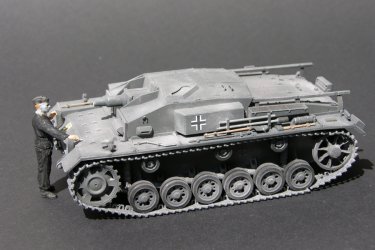
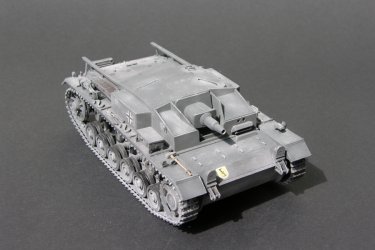
I would like to invite you to read the reflections of Mr. Janusz Wa³kuski on the subject of German armored weaponry used during the Warsaw Uprising of 1944. Maciej Janaszek-Seydlitz
Janusz Wa³kuski is born in Warsaw and certainly a Varsovian by spirit. He has lived in this city for a very long time and is linked with it emotionally. He has survived the Uprising at Wola and Stare Miasto (Old Town) districts.
The author is a man of renaissance. By education, he is a geodesist but he is a writer, a painter, a photographer and a model maker. He is also an excellent storyteller.
His text will introduce us to the realities of events at the time of the Uprising and will also bring us closer to the atmosphere of those difficult times.
German armored weaponry used during the Warsaw Uprising.
First, I would like to emphasize that I am not an armored weaponry expert and it is not my purpose to lecture on the subject of technical parameters of German weaponry or to describe its use during the Uprising. Those interested may please refer to subject literature, for example to the article by Janusz Ledwoch entitled "Warsaw 1944" in "Militaries of Twentieth Century" monthly, No.148, 2002.
During the Uprising time, I was just a less than 12-year-old boy, which came across German tanks four times. Those experiences connected with that have, after years, inspired me to take more interest in armored weaponry used by Germans.
When the Uprising burst out, I lived with my mom at Wola district, Chlodna Street 18, right across the Walicow Street and near the church of St. Boromeus. It was 1st of August, around 17 hrs. No serious activities around. Two German tanks have just stopped in front of our house. I was not able to say exactly what type they were, as it was not that simple to view them precisely. However, for a boy like me around 10 years old, it was an absolute necessity to take a look of such vehicles.
Three AK (underground Home Army) soldiers stood at the doorway to our house. The tanks were so near and they decided to shoot at them with their ... handguns. Fortunately, people from our house blew them up and took away from that absurd idea which could have ended up tragically for the occupants of our house.
I myself, together with other boys, claimed up to the third floor where our colleague lived in the apartment overlooking the street, to see how those tanks looked like. There was a place at Chlodna Street where German gendarmerie stayed, the famous Nordwache. When we started our looking at the street, the Germans noticed us in the window and shot several rounds from a machine gun over our house. Not much was missing and we could have paid with lives for our curiosity. That was my first meeting with the tanks. I saw them from the top but close enough. Certainly, I was not able to identify them. Most likely, they were just heavy self-propelled assault guns.
Taking this opportunity I would like to explain, what is the difference between heavy assault gun and the tank. The tank has a rotary turret, and the assault gun has not. The assault gun can move the barrel only within the range of several degrees; in other cases it is necessary to align the whole vehicle with the line of shot.
The Nordwache building was later captured by insurgents and it survived in its original shape till present days. A commemorative plate is fixed to its wall, however there are attempts to spoil its architecture by adding two additional floors. There are a numbers of protests by various associations, including the Association of Chlodna Street.
My next coming across the tanks has taken place in the Old Town district. In the first days of August we had to leave our place at Chlodna Street because German troops were approaching Wronia Street and the whole Chlodna and Elektoralna Streets were already under fire. Under these circumstances, we moved with my mom by foot to the Old City district. On 6th August, together with my mum we went for a walk, as there was actually no shooting around. People walked along the quiet streets, shops were open. My mom had a friend at Nowe Miasto (New Town) quarter and we went there to pay her a visit.
I took that opportunity and began to look around the Krasinskich Square. I did not know the Old City, and everything was interesting for me there. There was a wooden booth at the Krasinskich Square near Swietojerska Street. There were some bottles filled with petrol hidden behind that booth, apparently meant to be used against the tanks.
It so happened that two German tanks entered "from nowhere" the Krasinskich Square. People started to shout on me to hide. However, where could I likely hide if not behind the booth, with those petrol bottles behind it. If the Germans decided to fire at that booth, I would probably have not had an opportunity to tell you about that today. Fortunately for me, those tanks just moved around and then resigned of their mission and went back to Bonifraterska Street through the gap in the buildings. That was my second encounter with German tanks.
The third encounter, on 13th August, could have been very harmful for me because I had found myself in direct range of the explosion of the "trap tank" on Kilinski Square. I was injured quite seriously there. I can still feel that even these days. I managed to survive though, despite that over 300 persons have lost their lives there for sure, and some estimates say that even up to 500 persons could have died there.
It was an extraordinary case. There was not such a second massacre during the Uprising. There were cases though where during one bombing around thousand people were killed, such as e.g. in the Church of St. Jack, but they were not to be seen because they were buried under the rubble. Here, everything was seen, fragments of bodies everywhere. After the blast. I was unconscious for some time but after a number of days I had to stand up on my feet and that was my third time when I faced such an armored vehicle. The vehicle that blasted was not a tank, it was the armored vehicle. I will tell a little more about it later.
However, before that I will tell you about my fourth encounter with German tanks - the fourth and the last ones. On 2nd September, when "Starowka" (nickname of Old Town used by Varsovians) surrendered, the Germans took us out to the Mariensztat Market square. We were grouped there together with the other people brutally expelled from the Old Town. The place was half-crowded with people. There were three assault guns positioned on the Vistula river side of the market. I remember, they had characteristic short barrels. It was for sure the StuG III, the first model of German assault gun. They used the 75 mm caliber shells. There were also machine guns positioned before those guns and we were almost sure that Germans would use them, but they did not. We stayed there for some time and then they moved us from there. Meandering among the ruins because there were still fights there, we reached the Elektoralna and Chlodna streets and then the St. Adalbert Church. Everybody knows what has happened later.
 |
 |
Assault gun Sturmgeschütz StuG III Ausf. B Sd.Kfz 142/1: total weight 23 900 kg; length 5,40 m; width 2,93 m; height 1,98 m; max. speed 40 km/h; armoury: one short barrel assault gun caliber 75 mm, slow initial speed of shell, and 44 shells in stock; one machine gun MG 34, caliber 7,92 mm and 600 cartridges; crew: 4 soldiers.
I would like to tell now something about Borgward. This was the first use of this vehicle during the Uprising and nobody knew anything about it, including our intelligence service. That was simply new German equipment made in mid-1943 and used on a massive scale during the Warsaw Uprising. It was not armored and was operated either by radio waves or by one soldier.
On 13th August 1944, two assault guns StuG 40 escorted that Bogward vehicle from the Royal Castle Square side to the barricade set up across the Podwale Street. The vehicle was moving between those two assault guns. The purpose of that action was to destroy the barricade that was defending the access to the Old Town from the South. The intention of Germans and so the operator's was to slip off the chest of explosives load installed in front of the vehicle and detonate it after that Borgward vehicle would withdraw safely to the German positions. When Borgward moved near the barricade, these two assault guns went back.
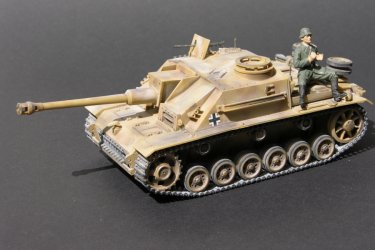 |
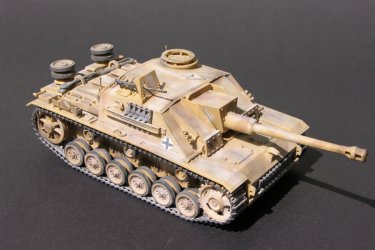 |
Assault gun Sturmgeschütz StuG 40 Ausf. III G Sd.Kfz 142/1: total weight: 23.900 kg; length: 5,56 m (without barrel); width: 2,95 m; height: 2,15 m; maximum speed: 40 km/h; armory: one assault gun cal. 75 mm; one machine gun MG 34 cal. 7,92 mm; the stock of munitions: 36 shells for an assault gun; 600 cartridges for the machine gun; crew: 4 soldiers.
It was a lot of junk and rubble in front of the barricade. Borgward climbed the barricade high but it got entangled in the junk and was not able to withdraw either. The insurgents threw some petrol bottles at it. The German operator of the vehicle jumped out and ran away to the nearest ruins. Busy with throwing the bottles, insurgents did not keep their guns ready to shoot and they just shot one series off the Schmeisser machine gun, but it did not hit him.
The vehicle went on fire but insurgents managed to extinguish it. Then the silence ensued. The Germans stopped fire. Usually, they used to tow a damaged vehicle back to their positions or to blow the wreck up using another weapons, such us e.g. Goliath. Here it was all different. Insurgents did not know what it was. They did not know that type of the vehicle; they thought it was just a light tank. When the Germans ceased fire, the fighters managed to start the engine and bring Borgward across the barricade to our side. The vehicle moved along Podwale Street towards Dluga Street.
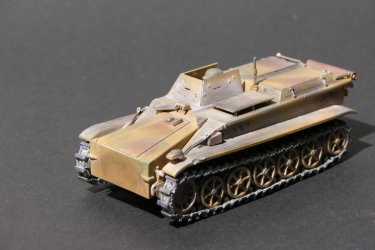 |
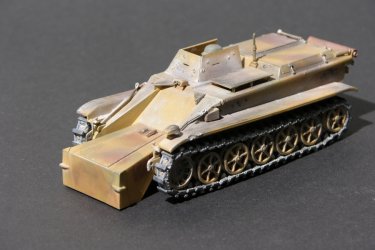 |
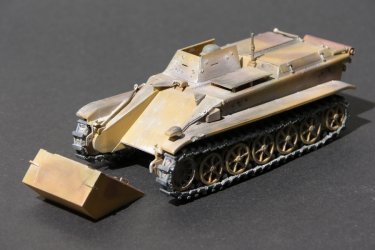 |
Armored transporter, heavy carrier of explosive loads Scherer Ladungsträger Borgward B IV SdKfz 301: total weight: 3450 kg; length: 3,35 m; width: 1,80 m; height: 1,25 m; maximum speed: 40 km/h; carrier of 450 kg of explosive material; crew: 1 soldier.
After some time, it turned right into Piekarska Street and then by Zapiecek Street it entered the Old Town Market Square. Many people gathered around it and wanted to admire the trophy. A young boy ran before the "tank" carrying national flag. Borgward proceeded from the Old Town Market Square and entered Nowomiejska Street. It was necessary to dismantle some elements of the barricades along its way to facilitate its movement. In the Old and New Town areas there were over fifty such barricades at the later stage of defense of "Starowka". There were several of them along the Borgward route. When the vehicle left Nowomiejska Street it turned left and stopped at Podwale Street just in front of my house at Podwale Street 29, right next to a concrete block (it still exists) and a passage to Szeroki Dunaj Street. At that time, both sides of the Podwale Street were densely built up. It was a rather narrow street; two horse carts had difficulties in passing each other.
Borgward stood near my house, and people were dismantling a part of the barricade at Podwale Street 23, where the PTTK (National Tourism Society) headquarters is located now, in order to let it move further. That took around 15-20 minutes. Meantime, the crowd was growing. Everybody wanted to get near the trophy. After making the opening in the barricade, Borgward moved further again.
Certainly, everybody would also like to take a ride, including myself. Taking the opportunity that Borgward stopped nearby I made my way through the crowd. At the beginning, I could not manage to hang up but eventually I succeeded. I grabbed a silencer with my one hand, caught some element with my leg and went so. A neighbor from our house, a certain Józio fellow, who also managed to climb the "tank", grabbed my other hand and it was fine, but gradually the silencer began to warm up and burn my hand. After a short while, the silencer had become so hot that I had to drop off the vehicle. I did not manage to catch it again and eventually Borgward turned right into Kilinskiego Street.
What happened later was described inter alias in the book by Robert Bielecki entitled "Dluga Street 7 in the Warsaw Uprising". Recent re-edition of that book is not available in retail sale at bookshops. The book was published in approximately 500 copies from private funds by prof. Mark Cieciura and he distributed it personally by hand among libraries and museums. It is worth to mention that while doing that, professor was sometimes mistaken by the messenger, despite that he was a rector of the one of Warsaw universities.
In my opinion, it is one of the best books about the Warsaw Uprising. That book is particularly close to me because the author presented there the monograph of the hospital on Dluga Street 7, that began to operate on 11 or 13th of August. It was the largest insurgent hospital in the Old Town. My mum worked as a volunteer nurse in that hospital. During German invasion period, my mom has undergone nursery training in the conspiracy, and when we moved to the Old Town, she reported herself on duty to the hospital. She continued to work there to the end of that hospital. At the end of August, I was also seriously wounded and my mom was nursing me outside the hospital. That probably saved her life because on 2nd September German troops captured the hospital and massacred several hundreds of hospital staff and its patients.
There is, however, some inconsistence in the book. Namely, the author wrote that Borgward stopped at Podwale Street 23, and waited there until the barricade was dismantled. It was not like that. I know that precisely, because I was a part of that event. I hanged on that Borgward until it turned right to Kilinskiego Street. It did not stop at Podwale Street 23, it simply passed that house. That street looked different at that time, everything was ruined and in rubbles.
When that Borgward turned into Kilinskiego Street, I simply had to give up riding. There was no chance to hang on its armor plate. There was no chance to get to it once more either.
I knew that my mother was back home from her shift in the hospital and fell asleep. She used to rest at home sleeping 3-4 hours a day, the rest of the time she spent in the hospital. I wanted to see her as soon as I could and tell her about the "tank" captured by insurgents.
I ran for a dozen or so meters and found myself 2-3 meters behind the corner in the place where the sidewalk was wider. I was just behind the corner when the blast took place. Those 2-3 meters saved my life. I was in the aftershock and turned back in order to look for my colleague - I had no idea what happened to him. His name was Antek, he was 2 years older from me, and he sat on top of the "tank".
One moment later, I lost my consciousness. As I learned later, two nurses dressed in "panterkas" (captured German military uniforms) picked me up. I was not able to hear anything. I could only see their lips moving. I was bleeding from my nose, throat and ears.
As I mentioned earlier, that Borgward had a releasable container that contained 500 kg of explosives mounted in front on the incline panel. Some people said that it was not necessarily a trotyl, judging by the colour of flames. At that time, the Germans simply were short of components to make the required amount of trotyl, and forced to use some substitute material that burns with the bright orange flames.
When Borgward made a turn and I got off that, the insurgent operator must have accidentally pulled some lever and the explosives box went down. It was likely that the timer of the detonator was activated at the moment when Borgward climbed the barricade. Alternatively, perhaps the insurgent operator had activated that by accident. We shall never learn the truth.
That incident at Kilinskiego Street was one of the reasons why I did take interest in tanks. I have read in the book "The Warsaw Uprising 1944" by Adam Borkiewicz that on Kilinskiego Street a small "Mark I" tank had blasted. In the next edition of the same book of 1957 another strange description was used, namely "Marek I".
Around 1960, I went to National Museum of Polish Military to learn more about that case. It happened that all German albums and books were classified and I could not read them.
General Stanislaw Komornicki (at that time a colonel) gave me a helping hand. Later he died in the air catastrophe in Smolensk on 10th April, 2010. He had very good relations with the librarians of the museum and they made available for me everything what was there on armored weapons. Because I saw before with my own eyes how that mysterious "tank" looked like, I was able to identify that without problem. I learned from the publications that it was named Borgward IV and manufactured in Bremen, Germany. I learned how thick were its armor plates, its dimensions, and other technical specifications.
After that, I started to talk about that "tank" at various occasions but to no effect. In those times, any publications referring to Warsaw Uprising were very limited. The truth was known only after 15-20 years, not necessarily because of my initiative. Other people also learned that it was Borgward IV.
Then I made my mind to make a model of Borgward, and because I knew that it was used together with those StuG guns, I also made a model of that assault gun. And that was the way it started. It appeared that there were other armored vehicles used during the Warsaw Uprising. I started to read publications on details of that type of weaponry and, as a result, I broadened my respective knowledge and subsequently decided that I would make models of all German armored vehicles used in Warsaw Uprising. Gradually, I made the whole collection. I will not give here the technical specifications of those armored vehicles. They can be relatively easily found in related literature, as well as on internet these days.
Let me get back for a while to Borgward. Adam Borkiewicz, when he wrote about "Marek I" most likely had in mind a light German tank called "Panzer I". Therefore, I also made a model of that tank in order to show the difference. Later on, some authors repeatedly quoted that mistaken interpretation of Borkiewicz until 70-ties.
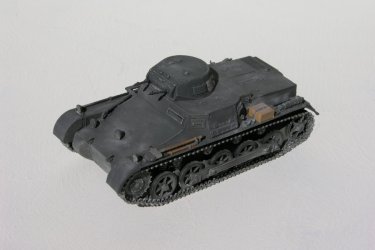 |
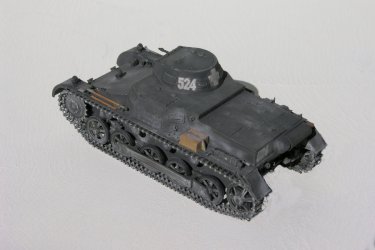 |
Light tank Panzerkampfwagen I: total weight 6,000 kg; length 4,42 m; width: 2,06 m; height: 1.72 m; maximum speed 40 km/h; armament: 2 machine guns, caliber 7,92 mm, ammunitions in stock 2,250 cartridges; crew: two soldiers.
The models I made are more illustrative than pictures in books or albums. They enable to view the tank or other armored vehicle at various angles and see all its details. All my models are made to identical scale, namely 1:35. The use of the same scale makes it easy to compare the dimensions of particular vehicles. As for the materials, I use the renowned sets from Japan, South Korea, and Italy. These materials guarantee that the models are precise and of excellent quality. Not bad sets are also made in Ukraine but their components are a bit too fragile. To better reflect the specifics of a battle I also put the silhouettes of soldiers around the vehicle models.
The development of a collection is a time consuming and costly task. To make one model takes usually 2-3 months. For instance, a model of "Tiger" contains over 900 components. The cost of a whole set is approximately 300 pln. There are, however, some extra costs such as: paints, an air-compressor and an aerograph. The price of the compressor is 400 pln, and the aerograph costs 600 pln. Therefore, such hobby is rather costly and usually young people cannot afford it. It is convenient that, in practice, all makes and types of model-making equipment are available on the market. They can be ordered easily and collected within a short time. The only limitations are financial resources.
I do not make my models at home. I went on understanding with one of the Wola district schools that makes one room available for me free of charge, but without any financial support. My colleagues and I provide the tools and materials. I make my models there, and give an opportunity for children to come and learn how to make models. I am there two times a week, 2-3 hours each day. It is excellent to feel that I am able to convey my knowledge and skills to children.
It is interesting that during many meetings with the youth on German armor weaponry the most interested in tanks were girls. Boys were more interested in fighter planes, like me. I supplemented my collection with a model of German bomber plane Stuka.
Making models of German armored vehicles was a new challenge for me. In principle, I am an aircraft model maker. I made a first aircraft model in 1947.
There are two approaches to making models. Some model makers make the models of tanks or aircrafts just for the model itself. They also copy the interiors including small details like control levers and indicators. Of the external elements, they copy registration number plates, names and numbers of combat units.
I am not much interested in making the interiors. The purpose of making my models is to bring people nearer to the truth and circumstances accompanying Warsaw Uprising. In my opinion, such models present a historical and documentary value for the future. Every detail and dimension can be demonstrated with them, and to some extent, they can replace the originals. There is no museum in Europe where all such vehicles are collected and displayed. For instance, in the Polish National Military Museum (1st floor) one can see the original Goliath vehicle and its caterpillars as well as the "Hetzer" vehicle in the yard of the museum.
It was I who used the pictures of my models in the so-called "parafabular version". Various writers and journalists use the pictures of my models. Various views of them can be taken: from the top or bottom, the front or back view, and son on.
I get two sets of pictures. One is documentary and another one consists of the same pictures composed with the background of insurgent Warsaw. They look, in my opinion, unique.
Let me make an attempt to estimate all armored vehicle force used by Germans during the Uprising. The data are not 100 percent correct. At the moment of the outburst, the German armored vehicle fleet in Warsaw was not large. First, because of the near battlefront, most of tanks and assault guns were moved East of Warsaw. Secondly, the German command was of the view that probable outburst of the uprising would increase the risk to destroy all armored vehicles left in town. The fact that Polish Home Army did not have any armored weapons caused that such strategy appeared to be most advantageous.
Only the development of fierce fighting in the city called "Polnishe Stalingrad" or "kleine Verdun" forced Germans to revise their standpoint. After that, the German armored force was greatly reinforced by bringing experienced armored force units withdrawn from the frontline.
At the beginning, there were only approximately 60-70 armored vehicles in Warsaw. On 17th August their number increased to 110 vehicles. After Praga part of Warsaw was taken over by Soviet-Polish army, the German armored weaponry in Warsaw was considerably reinforced.
During the uprising, Germans used relatively powerful armored combat units, well equipped with means adequate for battles in the city. During the last stage of battle for Warsaw, the well- equipped and trained front combat units were used. Many types of weapons were also used, with various effects.
For example, the common opinion prevails that many tanks of the PzKpfw VI "Tiger" were used. Perhaps because those tanks were mentioned in a very popular song of the "Parasol" soldiers written by "Ziutek". In fact, there were only five "Tigers" used in Warsaw and they did not achieve anything particular. On 31st July, those "Tigers" were discharged from the train at Brodno railway cargo station. Then they moved across Praga and Poniatowski Bridge, and reached the barracks at Rakowiecka Street. After the outburst of the uprising those tanks were used to shell the insurgent units within the Mokotow district.
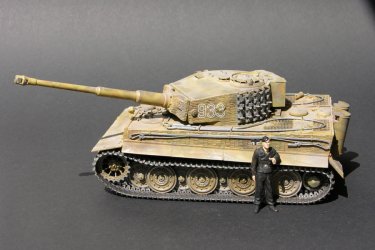 |
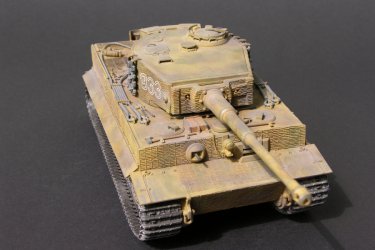 |
Heavy tank Panzerkampfwagen VI Tiger Sd. Kfz 181: total weight 57,000 kg; length: 6,32 m (8,45 m including a barrel); width: 3,73 m; height: 2,88 m; maximum speed on the road: 38 km/h, 20 km/h in the field; one artillery gun caliber 88 mm; two machine guns MG 34 caliber 7,92 mm; ammunitions stock for a gun: 92 shells, 5,850 cartridges for the machine guns; crew: 5 soldiers.
"Tigers" were positioned at the intersection of Pulawska and Rakowiecka Streets. They prevented insurgents from making the assault on German-occupied district, such as the Aleja Szucha Street area. Later, they were used for two days to transport wounded German soldiers across Mokotowskie air-field to a German hospital at Okecie district.
During the fighting within the Ochota district, the insurgents attacked "Tigers" using the grenade throwers (Panzerfausts) captured for Germans. One of the tanks was seriously damaged and the second one was taken over by the insurgents. However, due to lack of experience, it was grounded. The insurgents managed to remove its guns and after that it was destroyed by Germans with the use of the remote controlled Goliath tank. The other damaged "Tiger" was towed away by Germans and probably refurbished later.
The remaining Tigers were quickly withdrawn from the battle. That tank was too precious to be used just for a street battle. Several days later the remaining three "Tigers" were moved out of Warsaw.
"Tigers" were the best and heaviest German tanks. They had a very thick armor plates and an artillery gun caliber 88 mm, while most of German tanks had guns of 75 mm caliber. During the World War II, Germany made approximately 1,330 or 1,350 "Tigers" and approximately 850 of "Royal Tigers". In comparison, the Russians made approx. 35,000 of T-34 tanks, and the Americans 60,000 of Sherman tanks. None of those tanks had a chance to win in the direct encounter with "Tiger". Its weakness however was the heavy weight.
The mid-size tanks PzKpfw V "Panther" were much more used in Warsaw Uprising. There is an interesting story about that. On 2nd August, all of a sudden, three "Panther" tanks found themselves on Karolkowa Street. They were moving down the Karolkowa Street towards Zytnia and Mareckiego Streets. They passed Mareckiego Street and entered Okopowa Street. There, the insurgent soldiers from the "Soaks" battalion threw hand grenades at them. The tanks went on fire but one of them managed to escape across Kercelego Square. Nobody knew what happened to it because there was no wreck found. The remaining two "Panthers" were captured by the insurgents. One of them was seriously damaged by an English-made grenade that was a part of military supplies air-dropped by the Allies as an aid to the Uprising. It was called a gammon.
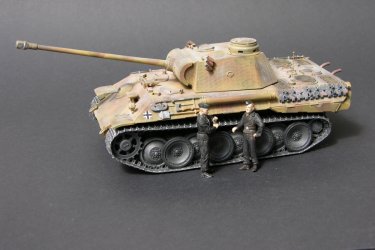 |
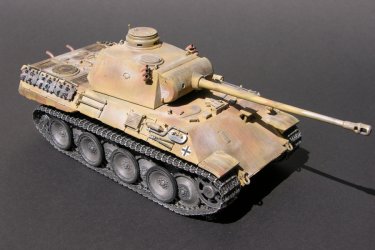 |
Mid-size Panzerkampfwagen VA Panther SdKfz 171: total weight 45,500 kg, length 6,88 m (8,66 m with a gun barrel); width 3,43 m; height 3,10 m; maximum speed on the road 46 km/h, 24 km/h in the field; artillery gun caliber 75 mm, two machine guns MG 34, caliber 7,92 mm; stock of ammunitions: 79 shells; 4,200 cartridges for the machine guns; crew: five soldiers.
In fact, it was a very heavy anti-tank type grenade that was able to make such a big hole in the armor plate that a man could pass through it.
Insurgents wanted very much to use the captured tanks. They did not know, however, how to start the engine. At last, they had found a man who knew how to do that. Together with a prisoner, who was either Austrian or Slovak and able to speak some Polish, they managed to start one of the engines. That tank was named "Magda". The other one had the electric circuits broken down and it was hard to start it. There was a common problem with both tanks, namely, their batteries were poor. Therefore, insurgents moved around searching for the car batteries and fuel.
Eventually, both tanks were fixed. One of them had some problems because something was wrong but "Magda" presented itself quite well. On 4th August, the insurgents wanted to make a trial shot from its gun. There is such a drill that in order to test if everything is all right with a gun barrel, one needs to make at least one shot.
Because insurgents did not want to waste even one shell, they decided to point the gun at the nest of German machine gun located at the St. Augustin church tower within the Jewish ghetto area. The shot was successful, and the machine-gun nest was completely smashed.
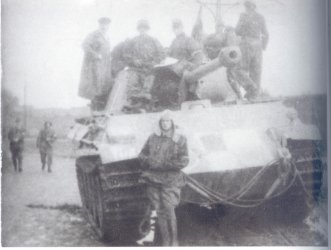 |
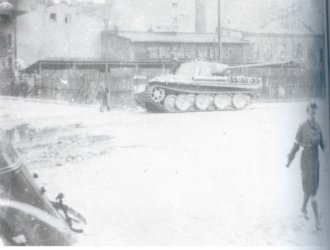 |
Captured Panther "Magda"
On the same day, in the afternoon, the Home Army troops thrown an assault on the St. Zofia hospital and a school on the corner of Zelazna and Leszno Streets, the one I attended just two months before. That assault was unfortunately poorly arranged and it failed. "Panther" however did its job and forced Germans to move from the school to St. Zofia hospital.
What happened to those tanks is precisely described in literature. On 5th August, an attack was thrown on Gesiowka prison. It was captured with an outstanding assistance of "Magda". The previous day, during the attack on the school and the hospital, its turret was damaged, and the tank had to aim the target by maneuvering itself. Later on, the problem was fixed and the tank was fully useful.
Incidentally, plenty of gun shells were available, because earlier the insurgents captured a German truck fully loaded with the artillery shells. That way, owing to "Magda" the Gesiowka prison was captured and the prisoners, Poles and Jews, were freed. Over two next days that "Panther" was used to shell German positions within the area of "Radoslaw" and "Chrobry II" groupings.
On 2nd August, in the morning, the second "Panther" (the one with the big hole burnt by the shell) was positioned on Karolkowa Street. All of a sudden, an assault artillery gun appeared, most likely the StuG III. It shot at our "Panther" and hit it three times. Fortunately, some insurgents were just slightly wounded. The second Polish Panther "Magda" stood at Mareckiego Street. When its crew learned what was happening, they hurried immediately to help. "Magda" shot at StuG and seriously damaged it, maybe even smashed it completely. It was a very spectacular action: our "Magda" destroyed German tank.
Unfortunately, the other Polish "Panther" - after it was hit three times again - was not in shape for any more action and it was deliberately set on fire. Meantime, on 11th August, the insurgents left Wola district and negotiating the ghetto area reached the Old Town. Before that, they destroyed their tank.
It is to be remembered that the gun of "Panther" is much more effective because of the long barrel that gives the shell a very high initial speed and its crushing effect is enormous. No other tank of the World War II was able to defy "Panther", with the exception of "Tiger".
There were approximately 80 "Panthers" used by Germans during the Uprising.
Most of the tanks used by Germans in Warsaw in 1944 were mid-size tanks PzKpfw IV type. Those tanks composed the II Panzer Corps Hermann Göring that was stationed at Ulrichow quarter within the Wola district. Those tanks had considerable impact on the fate of uprising within the Wola district.
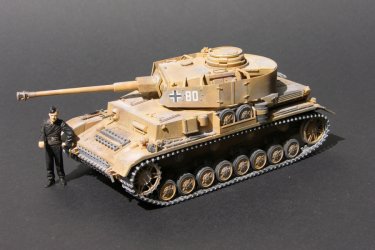 |
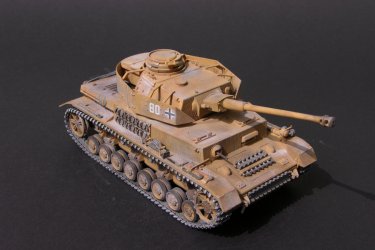 |
Mid-size tank Panzerkampfwagen IV Ausf. H Sd.Kfz 161. Total weight 25,000 kg; length 5,89 m (7,02 m including a gun barrel); width 3,3 m; height 2,68 m; maximum speed 38 km/h; armoury one artillery gun caliber 75 mm; two MG 34 machine guns caliber 7,92 mm; stock of gun shells: 87; 3,150 cartridges for the machine gun; crew: 5 soldiers.
That was the most commonly used German tank during the Second World War. Germany manufactured over 6,500 of that type of tank. Totally there were approximately 100 of such tanks used during the Warsaw Uprising. Some of them were destroyed or damaged by insurgents.
The RONA (Russian Liberation Peoples' Army) units that took part in the bloody "pacification" of Wola district and later of the other Warsaw districts were equipped with two armored vehicles used for the communication purposes, namely Sd Kfz 263 (8x8).
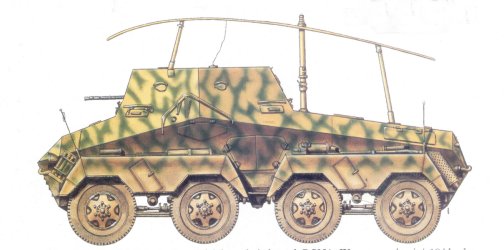
Reconnaissance type armored vehicle (a radio-communication version) Schwerer Panzerspahwagen (8 wheels) Sd Kfz. 263; total weight 8,300 kg; length 5,85 m; width 2,20 m; height 2,35 m; maximum road speed 85 km/h, 30 km/h in the field; armory: one MG 34 machine gun; crew: 6 soldiers.
One of those vehicles was destroyed by "our" Panther "Magda".
At the time the Uprising began, German forces had four or five Italian mid-size tanks PzKpfw M 14/41. They stationed in Aleja Szucha Street.
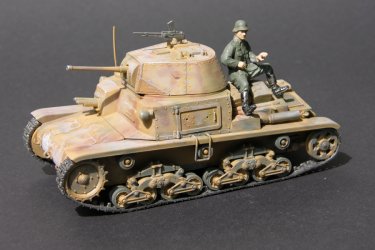 |
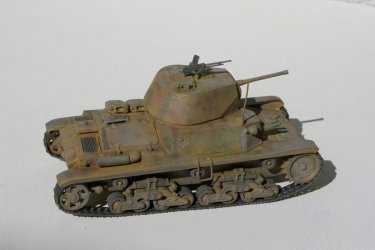 |
Mid-size Italian tank Panzerkampfwagen M14/41 736(i). Total weight 14,000 kg, length 4,92 m; width 2,20 m; height 2,38 m; maximum road speed 32 km/h, 14 km/h in the field; Armory: one artillery gun caliber 47 mm; two Breda machine guns caliber 8 mm; stock of ammunitions for the gun: 104 shells; 4,200 cartridges for machine guns; crew: four soldiers.
On 5th August, when the insurgents attempted to capture the so-called small PASTA building at Pius XI Street (at present Piekna Street) one Italian tank was destroyed that was sent by the SS and Police commander Geibel with their troops to help Germans defending PASTA. The second tank was destroyed on 3rd September in the Lipowa Street during German attack on Powisle district.
Besides those tanks, Germans used many assault artillery guns. Their task was in principle to destroy the enemy's fortifications as well as armored weapons, but in the uprising they were used mainly to back up German infantry. Those were the StuG III and StuG IV guns mentioned earlier as well as the tank destroyers "Hetzer".
At the end of July, twenty eight "Hetzers" that were to go to the East front were unloaded from the train in Warsaw. They were kept in Warsaw because the front was approaching the city and used in the street battles.
One "Hetzer" was captured by the insurgents in Srodmiescie district (downtown). On 2nd August two "Hetzers" moved from Krakowskie Przedmiescie Street and passing Swiêtokrzyska Street reached the Napoleon's Square. There, the insurgents threw petrol bottles and grenades at them and set them on fire. One was destroyed or escaped, I cannot remember that well. The other one was seized.
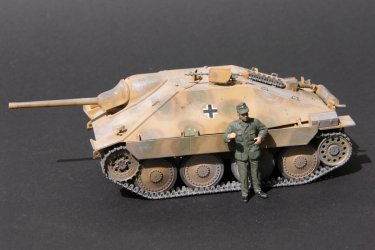 |
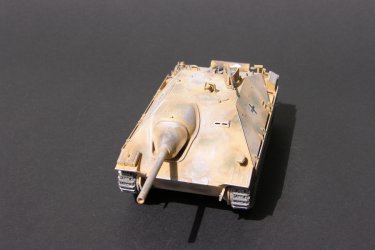 |
Tank destroyer Jagdpanzer Hetzer 138/2. Total weight 16,000 kg; length 4,87 m; width 2,63 m; height 2,10 m; maximum speed on the road 40 km/h, 14 km/h in the field; one artillery gun caliber 75 mm; one MG 34 machine gun caliber 7,92 mm; Stock of ammunitions: 40 gun shells, 500 cartridges for the machine gun; crew: four soldiers.
In the evening of 2nd August, the captured "Hetzer" was towed away by the soldiers of "Kilinski" battalion and put in the barricade on Szpitalna Street. Our experts considered that that vehicle should be fixed and used as a mobile shooting point. It was then towed towards the Central Post Office building at Napoleon's Square where the automobile workshops were located. There, that "Hetzer" was fixed on 12th August and it was given the name "Chwat", painted in white on its armor plates.
The idea was to use that "Chwat" vehicle in the area of Post Office at Zelazna Street or of PASTA and Krolewska Street, but the command thought that it would be necessary to dismantle some barricades in order to let it pass, and that would certainly weaken our defense system. Under those circumstances, "Hater" stayed at General Post Office. There was a heavy bombing raid on 5th September aimed at General Post Office and as a result, "Hetzer" was buried under the fallen wall. It was covered by the debris and stayed like that by the time Warsaw was liberated in 1945. After the war, it was recovered from ruins and moved to National Military Museum in Warsaw where it can be seen nowadays.
"Hetzer" was the assault artillery gun designed to destroy tanks. It used special shells. The insurgents destroyed many "Hetzers" in various places.
Besides the afore-mentioned assault artillery guns, Germans also used another assault artillery gun named Marder III Sd. Kfz 138. It was the first of the series of German tank destroyers that used the chassis of Czech tank PzKpfw 26(t).
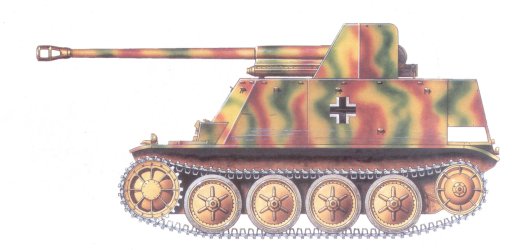
Tank destroyer built on the chassis of Czech tank PzKpfw 38(t) Jagdpanzer Marder III Sd. Kfz 138. Total weight 10,800 kg; length 6,36 m; width 2,29 m; heigth 2.20 m; Maximum speed on the road 40 km/h. Arms: one artillery gun caliber 75 mm; one MG 34 machine gun; the stock of ammunitions: 27 gun shells, crew: four soldiers.
In this picture Marder can be seen as standing in Wolska Street and witnessing the exodus of the Varsovians expelled from the city when the Uprising failed.
In Stalingrad, Germans experienced what does it mean to fight for every single building. They did not get at that time any tank or assault artillery gun able to make it through the town. Every ordinary tank that entered the street was immediately set on fire by Russians. It was the same in Warsaw. In order to solve that problem, Germans made an armored assault artillery gun that was able to shoot and destroy the whole buildings or barricades with a direct fire.
Sturmpanzer VI "Tiger-Mörser" was built upon the chassis of a "Tiger" tank - the mightiest tank of the Second World War. It was armed with the rocket grenade thrower, caliber 380 mm. The components of marine depth bombs were used in that grenade thrower. The "Sturm Tiger" had its own crane to handle its heavy shells. It also had very thick armor plates, because its aim was not to take part in the battle but approach the barricade and blow it up with direct fire. It also used to crash the whole buildings one by one.
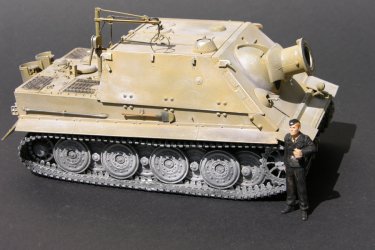 |
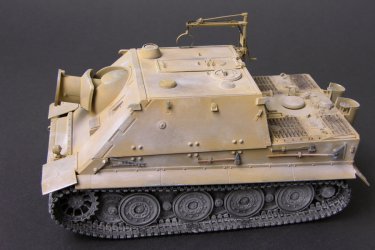 |
Tank with rocket grenade thrower Sturmpanzer VI; Sturm tiger; Tiger-Mörser: total weight 65,000 kg; length 6,28 m; width 3,73 m; heigth 3,46 m (including crane); maximum speed 38 km/h; arms: one rocket grenade thrower caliber 380 mmm; one MG machine gun caliber 7,92 mm; stock of ammunitions 14 rocket grenades; crew 6 soldiers.
Two such grenade throwers were most likely used in Warsaw, but despite the fact that it was a new German weapon specially designed for street fighting, they rather did not meet the Germans' expectations. They were too heavy and not mobile.
There was yet another artillery gun, also designed basically for street fighting. It was the artillery assault gun Sturmpanzer IV "Brumbar". They used very heavy shells, both demolition and incendiary type. In fact, it was a 150 mm caliber howitzer.
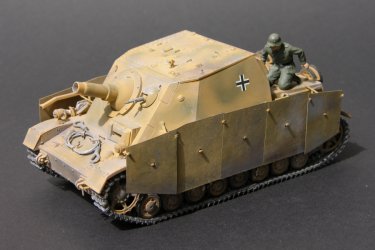 |
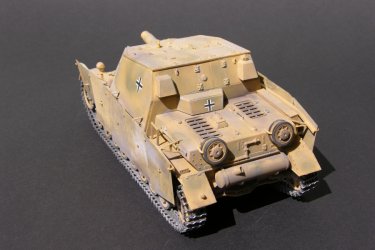 |
Howitzer Sturmpanzer IV Brumbar Sd Kfz 166: Total weight 28,200 kg; length 5,93 m; width 2,88 m; height 2,52 m; maximum speed 38 km/h; arms: howitzer caliber 150 mm; one MG 34 machine gun caliber 7,92 mm; stock of ammunitions 38 shells; 600 cartridges for the machine gun; crew: 5 soldiers.
What is the difference between the howitzer and ordinary artillery gun? The howitzer, like the grenade thrower, can lift its barrel high. The shell then flies using high trajectory that was particularly useful in town because it enabled to shoot directly at buildings, windows, fire points, etc. from a short distance. Those Brumbars were very good at their bloody job in Warsaw. It was more than ten of them in Warsaw and they were deadly efficient.
There was yet another weapon that was particularly disturbing, also directly myself in the Old Town. It carried on a heavy shelling. That was the rocket thrower called by the Varsovians a "cow" or a "wardrobe" because of the unique roaring, grating or squeaking sound produced by the launched rockets. The rockets of the caliber 260 or 320 mm were launched in the series of six. One series used to contain four crushing and two incendiary rockets. There was no way of defense against them. The only thing one could do at the moment the launch of the rockets was heard was to find some shelter, cover ones' ears and open the mouth. The exploding rockets caused a very strong blast. I personally survived several explosions of the "cow".
Those rocket throwers were set up directly on the ground. The aiming was done by changing the direction and angle of the rocket-guiding rails.
The rocket throwers were also installed on the very successful model of the caterpillar transporter. It was widely used in German army, inter alia as the mobile platform for carrying and launching the 28/32 mm rockets Raketenwerfer Sd. Kfz. 251/1 Aus. C Stuka.
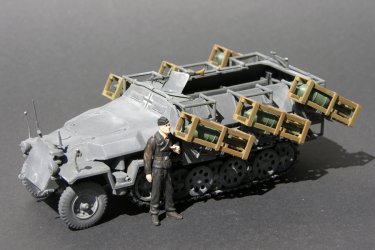 |
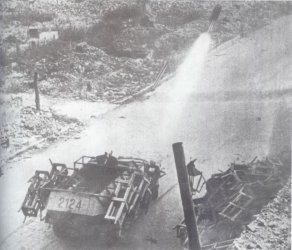 |
Armored transporter carrying the 28/32 cm rocket thrower Raketenwerfer Sd.Kfz. 251/1 Aus. Stuka: total weight 8,000 kg; length 5,80 m; width 2,10 m (without rockets); height 1,75 m (without the machine gun shield); maximum speed 63 km/h; weapons: rocket thrower 28/32 cm; one MG 34 machine gun; stock of munitions: rounds of 6 rockets, 2,500 cartridges for the machine gun; crew: up to 12 soldiers.
The crew was usually seven people. This arrangement was considered perfect to ensure both the mobility of the platform and precise aiming process. Both the insurgents and citizens considered it a very distressing and deadly weapon.
A semi-caterpillar transporter Mittlerer Schützenpanzerwagen Sd Kfz 251/1 was used by Germans also to support the infantry attacks or transport their wounded soldiers. One of those vehicles was seized by the insurgents in the Powisle quarter on 14th August. It was given the name " Jas" and, together with the armored vehicle "Kubus" designed and manufactured by the insurgents in conspiracy, was stationed in the backyard of Konserwatorium (Music Academy) at Okolnik Street. Both vehicles took part in the attacks on the University of Warsaw. After the first attack, "Jas" was renamed to "Szary Wilk" in order to pay homage to the commander who died during the attack.
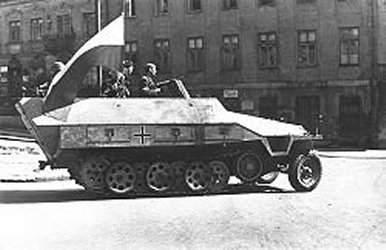
Semi-caterpillar armored transporter Mittlerer Schützenpanzerwagen Sd. Kfz 251/1: total weight 8,500 kg; length 5,80 m; width 2,10 m; height 1,75 m (without the machine gun shield); maximum speed 52 km/h on the road, 21 km/h in the field; weapons: two machine guns MG 34 caliber 7,92 mm, crew two soldiers.
"Szary Wilk" did not return to Okolnik Street, It was damaged on purpose and left on Konopczynskiego Street. The damaged wreck was most likely taken back by Germans. "Kubus" was also damaged on purpose before the insurgents left their positions there. In 1945, "Kubus" was still standing on Okolnik Street. Later on it was transported to National Military Museum and can be seen over there at present.
The second armored transporter Sd Kfz 251 was seized by the insurgents on Zamkowy Square on 5th August. It went on fire, and after the fire was extinguished, it was moved to Kanonia Street. Then the insurgents took over the following military equipment: two grenade throwers (Panzerfaust) and a box of primers for them; fifty pieces of land mines (2 and 3 kg of weight); approx. 100 kg of explosive charges and 250 m of blasting fuse, and many cartridges for machine guns. That seized vehicle was of no use in the narrow streets blocked by barricades. It was then positioned next to the bell tower of the Saint John Cathedral, where it served as a barricade to the last days of fight for the cathedral.
German armored train "Panzerzug 75" operated along the circular railway line from Warszawa Gdanska Station to Warszawa Zachodnia Station. It carried a number of 75 mm caliber artillery guns and 105 mm caliber howitzers, 22 mm caliber anti-aircraft guns, and one light reconnaissance tank PzKpfw 38(t) made in Czechoslovakia.
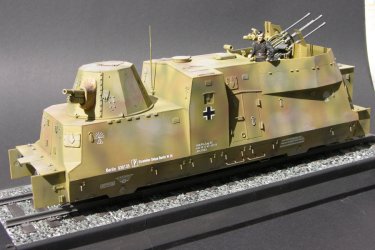 |
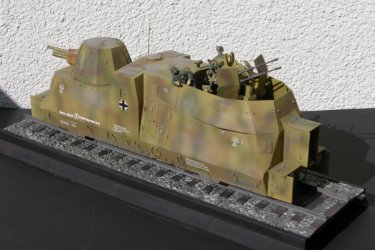 |
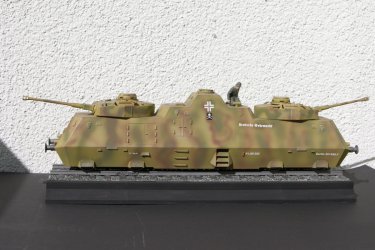 |
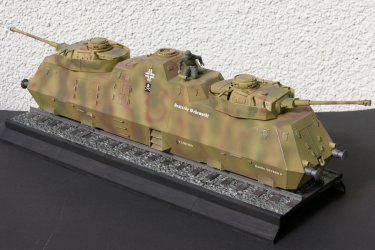 |
Panzerzug 75
Moving along that railway line, it carried on shelling the Wola, Powazki, and Stare Miasto (Old Town) districts as well as the PWPW (State Mint) complex. At the corner of Tatarska and Ostroroga Streets, the soldiers from "Zoska" battalion attempted to capture that armored train, however without success. All soldiers died during the attack.
Meanwhile, Germans started to bring to Warsaw more and more of heavy weapons because they could not tackle the growing resistance. Among those arms was the most heavy mobile siege-type grenade thrower caliber 600 mm Karl Gerät 040 "Ziu".
Karl was made specially to destroy Russian sturdy shelters and fortifications at Sewastopol. It was moved from there to Warsaw and positioned on the specially designed stand in the Sowinski Parc of Wola District. The second such stand was constructed on the yard of the Lilpop's Factory, but it was not used.
There were two versions of that grenade thrower. That of Warsaw was the 600 mm caliber, but there was yet another one of the 550 mm caliber and its range of fire was slightly bigger. It was able to throw charges (missiles) for the distance of several kilometers. The length of the missile was 2 meters, and its weight was 2,200 kg. The crew was 107 soldiers.
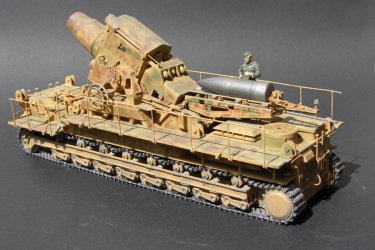 |
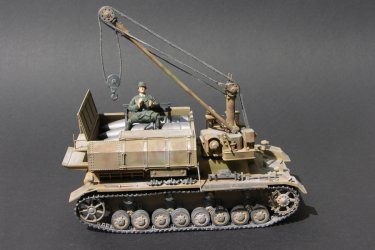 |
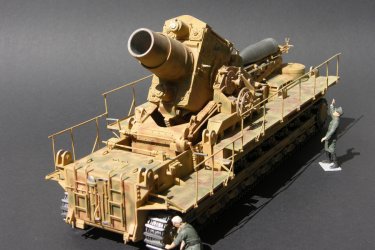 |
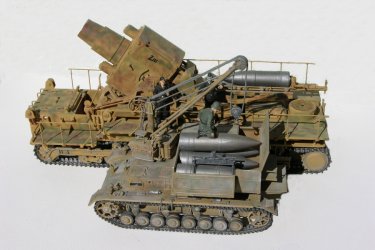 |
Heaviest mobile siege-type grenade thrower cal. 600 mm Karl Gerät 040 "Ziu": total weight 124,000 kg; length 11,15 m; width 3,16 m; height 4,78 m; max. speed 8-10 km/h on the road; arms: one grenade thrower cal. 600 mm; equipment: one crane for loading missiles built on a modified version of PzKpfw IV tank; crew: 15-17 soldiers; 109 persons including police and the anti-aircraft defense.
Karl was in principle self-mobile, it moved on caterpillars but it had limitations because of its heavy weight. It used to be carried on a special railway lorry and brought to its fire stand. The whole operation to make it ready to shoot took about a week.
Missiles were carried by the special above-mentioned vehicle based on a mid-size tank PzKpfw IV and equipped with a heavy crane. That grenade thrower was able to shoot many charges per hour, but Germans had only 240 of them available. In fact, there were just approximately 30 missiles shot in Warsaw. That figure, however, still needs to be verified.
To tell the truth, Karl did not succeed in Warsaw. Its charges were designed to crush heavy fortifications. The missile was able to penetrate the 2,5 meter thick layer of concrete and then explode. In Warsaw, and in the Old Town in particular, houses were not of heavy construction. Many old houses, and in the Old Town practically all, had wooden roofs and ceilings. Only walls were thick. The fuses of Karl missiles were simply not properly designed (too hard). They were able to penetrate roofs and ceilings but did not explode inside. There were many of such unexploded missiles that were later used by insurgents. They can be seen on some pictures taking out the explosives from inside the missile, that it was later used for the manufacturing of hand grenades.
It was interesting that Germans wanted to withdraw that Karl from Warsaw and move it to Paris where similar uprising burst out at the same time, however Paris was captured quickly by the Allies and Germans simply could not move Karl to Paris in time.
In addition to that heavy weaponry, Germans kept an armored river cutter on Vistula river that continued shelling the Old Town. Its record is very interesting. It was built at the Modlin Shipyard of the State Engineering Works in 1932-1934 as an armored cutter "Nieuchwytny" (imperceptible) that was assigned to the River Fleet of the Naval Force - the Separate Unit (SU) of the Vistula River. As the only battleship of the SU "Wisla" (Vistula), it enjoyed the nomination ORP (the battleship of the Republic of Poland) and a regular navy officer was in its command. During the September 1939 war campaign it was engaged in the battles inside the region covered by the "Pomorze" ("Pomerania") Army. Its armament included: one anti-aircraft gun Bofors, caliber 37 mm; one caliber 37 mm armor-piercing Puteaux gun; one anti-aircraft machine gun cal. 7,92 mm. On 2nd September, near the bridge in Fordon, the crew shot down three German bombers. The cutter was not able to make its way to Modlin, the crew decided to sink it at Poplacin near Plock on 10th September 1939.
The Germans recovered the cutter and assigned it as Pomerkanonenboat Wachtkutter "Pionier" to an engineer squad operating along the Vistula river. In 1944 it was re-armed with the two anti-aircraft guns, caliber 37 mm, and the fourfold (4 x 12,7 mm, or 7,92 mm) Vierling machine gun. It was later stationed in the Czerniakowski river harbor and its main task was the anti-aircraft defense of the Kierbedzia bridge.
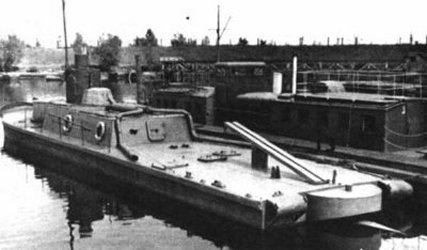 |
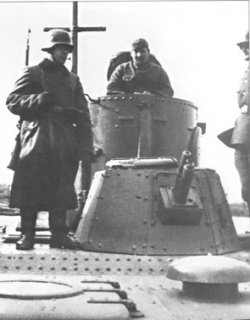 |
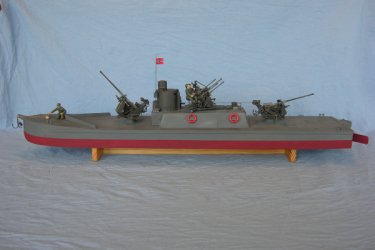 |
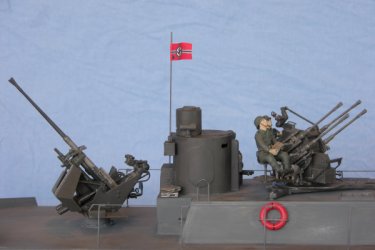 |
The cutter "Pionier"
Our insurgents planned the attack on the cutter. A group of fifty soldiers of the "Szczupak" squad led by Commander Lieutenant Wladyslaw Macoch, nickname "Mizio", was assigned to that task. "Szczupak" squad was a part of the Marine Group "Alfa" of the Home Army.
On 1st August the concentration of "Szczupak" squad took place in the building of Waterways Authority, not more than 50 meters distant from the harbor gateway. However, an alarm was made at 16.30 hrs for the whole German Garrison and subsequently the cutter left the harbor a couple of minutes before 17.00 hrs and made it to the river. Under the circumstances, the whole action of "Szczupak" squad had to be cancelled. The squad itself was later assigned to "Kryska" concentration as the fourth platoon of the "Tur" battalion.
On 6th August 1944, that "Pionier" cutter kept fire from Citadel section of Vistula on the Old Town and later extended it to the northern part of Powisle district. On the nights of 27th and 28th August, "Pionier" safeguarded the movement of German tanks from Saska Kepa district to Czerniakow and Sadyba districts. The last recorded action of "Pionier" was the shelling of Czerniakow and Powisle districts, including the river harbor.
When the Russian army troops took Praga part of Warsaw, the cutter was re-assigned down the river. When the Russian offensive started at the beginning of January 1945, the German crew sunk it again near Plock.
After the war, the cutter was surfaced again and refurbished. In 1947-1955, as the ORP "Okon" it served in Szczecinski Maritime Region, and in 1955-1957 it was assigned to Military Frontier Guards. In 1957, it was withdrawn from service and it was scrapped in 1973. It is to be regretted that such unique military equipment with such splendid history could not have been saved from scrapping and placed, for instance in the yard of National Military Museum or inside the Modlin fortress. Its length of 23 m would certainly allow for that.
Besides that, the Germans used approximately 30 Stuka warplanes. That Stuka presented in my view the biggest cruelty one could imagine. It was terrible weapon. Their air raids over Old Town lasted from 8 hrs in the morning till 8 hrs in the evening, with a short meal break to allow Germans to eat - they worked so hard after all.
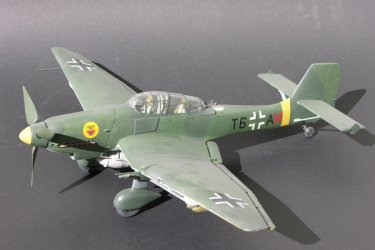 |
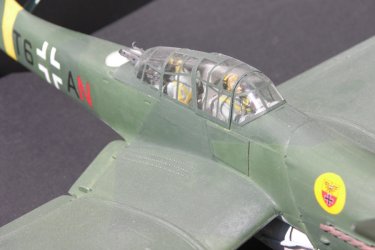 |
The one-engine dive-bomber Junkers Ju 87 Stuka: wing span 13,80 m; length 11,10 m; height 4,01 m; total weight at start 4,250 kg; maximum speed 380 km/h; range 790 km; arms: two machine guns MG 17 caliber 7,92 mm and 700 kg of bombs; crew: two airmen (a pilot and a gunman/radio operator)
At the beginning of the Uprising, on 4th August, when we still lived at Wola district we have experienced our first bombardment near Hala Mirowska. We stayed in our place at Ciepla Street. German bombs hit our building twice, and we were buried in the debris but people fortunately dug us out. I always had interest in planes and I learned that those were Heinkel 111 bombers, a dozen or so of them.
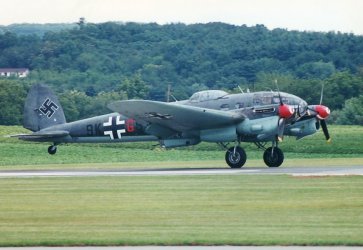 |
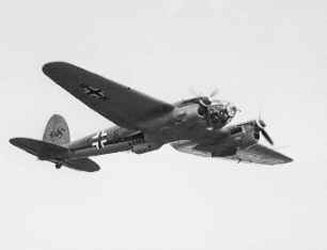 |
The two-engine mid-size bomber Heinkel He 111: wing span 22,50 m; length 16,40 m; height 3,90 m; weight at start 14,075 kg; maximum speed 400 km/h; meteor 8,390 m; range: 2,800 km; arms: six MG 15 caliber 7,92 mm machine guns and up to 2,500 kg of bombs; crew: five airmen (a pilot, one navigator/bombardier, and three gunmen)
During the Uprising, Germans used for the first time the so-called chained bombs. They were probably short of large bombs and decided to chain seven smaller bombs in order to achieve the same result as if it was just one large bomb. Such arrangement was used when Ciepla Street was bombed. My mom went to our friend's place where the gas stove was still in operation, in order to cook a dinner.
The first air raid took place around 15.00 hrs. We were not burred under the debris that time but I was injured. I stood in the building gate where many petrol bottles were stored, and the bombs hit nearby.
I was penetrated with pieces of glass and soaked with petrol. If there were any spark there, I would perhaps look nice like a torch in the darkness of the gate, and certainly would not tell you about that event now.
German bombers operated almost over the whole period of the uprising, totally undisturbed, while the Russian fighter planes were idling nearby Warsaw somewhere at the bank of Vistula river.
I supplemented my model collection by the model of Heinkel 111 "Stuka".
Besides Borgward IV armed vehicles used for crushing the barricades and walls, the Germans also used smaller, not manned vehicles called "Goliath".
I will tell now a few words about them. Fifty were used in Warsaw. There were two versions of them. Generally, it was believed that they were driven by an electric motor and carried batteries. It appeared though that electric motors were not convenient to be used in the battle, because batteries needed to be charged and properly maintained. "Goliath" was equipped with the two expensive electric motors and carried only 60 kg of explosives. Therefore, "Goliath" was later modified. Instead of being driven by the electric motor, the internal combustion engine was used, most likely taken from the "Zündapp" motorcycle.
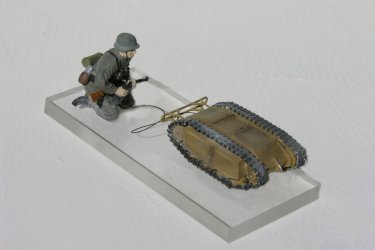 |
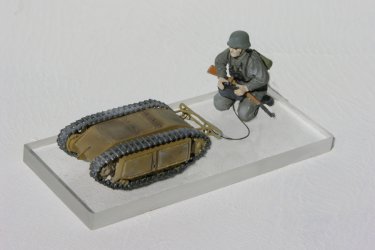 |
The explosives carrier Ladungsträgger Goliath SdKfz 302: total weight 370 kg; length 1,50 m; width 0,85 m; height 0,56 m; maximum speed 10 km/h; range: 1,5 km on the road, 800 m in the field; 60 kg of explosives, no crew, remote-controlled
How did the "Goliath" work? There was an electric cable drum fixed in the back of its chassis. The length of the cable was up to 1,500 m. The system enabled to control "Goliath" manually - by that cable - as well as trigger the explosion of the material inside.
In order to put "Goliath" out of action, somebody had to cut that cable. An ordinary small shovel in the hands of a brave soldier was good for that, provided he could get close enough to it. There were many cases like that in Warsaw. The explosives gained that way from "Goliaths" were later used for the manufacturing of hand grenades.
A small digression: there is a fragment of the tank caterpillar inserted in the wall of the Saint John Cathedral in the Old Town, and the inscription goes that it is the "Goliath" caterpillar, which is not true. Each section of the "Goliath" caterpillar was made of the pressed and bent steel. An economic calculation was behind that, because "Goliath" was the one-time-use (expendable) type of vehicle.
The caterpillar inserted in the wall of the cathedral has the link elements made of cast steel and connected with solid steel bolts. It is therefore a portion of the drive chain of another vehicle. I personally checked the dimensions of the links. Then I took measurements of the Borgward caterpillar model made to the 1:35 scale. The dimensions proved to be identical; the fragment of the caterpillar mounted in the wall of the cathedral belongs to Borgward IV, perhaps the same that exploded on 13th August 1944 in Kilinskiego Street.
Similar fact-description mistakes can be found in the post-uprising literature or in the reports of witnesses of some other events.
To summarize, it could be stated that Germans used a huge amount of armored troops equipped with special means intended for street fights in the city. Borgward IV and "Goliath" vehicles were used on a mass scale, as well as the assault guns Brümbar, Sturm Tigers, and Hetzers. It looks that it was a terrible idea to use such weapon as 600 mm caliber grenade thrower Karl against the fragile city buildings. The demolishing force of German artillery was enormous.
What the insurgents had to defend themselves against that force and trying to destroy German armored vehicles?
They had, for instance, two Polish-made armor-piercing guns, caliber 37 mm, the Bofors model, if I am not wrong. They were buried in the ground by Polish soldiers in 1939. They were found after the uprising burst and there were attempts to put them in order, not necessarily successful. There was one armor-piercing gun seized by the insurgents in the Powisle district, and used in the same place as the Polish armored vehicle "Kubus".
In mid-August, in the process of the attack on Stawki Street, one detachment of soldiers of the "Chrobry I" concentration group seized the 50 mm artillery gun and the crawler, and 50 missiles - unfortunately not of the armor-piercing type. That gun helped to defend the insurgents against German assaults, and it destroyed one Borgward that moved towards the Simmons Passage. The gun was placed in the body of the barricade linking the Simmons Passage and Arsenal in order to strengthen the "Chrobry I" front line. Later, the gun was moved to the gateway of Simmons Passage, and most likely, it was destroyed during one of the bombings of the passage.
At 1st August, the insurgents had at their disposal a number of armor-piercing guns and English-made "Piats" gained from the supplies by the Allies. taken over outside the town and then brought to Warsaw. Altogether, there were 29 pieces of those guns. They also had approx. 30 flame-throwers manufactured at clandestine arms workshops before the Uprising. They were used mainly against German tanks, but also when "PASTA" building was attacked and captured.
Besides that, there were hand grenades - Polish-made from 1939, and German-made. Altogether, there were 43,970 pieces in the inventory. Some of them were used against tanks, but most was not suitable for that.
There were also petrol bottles. If thrown at a tank jointly with the grenade, it could set the tank on fire. The inventory on 1st August was 12,000 bottles. During the uprising, hand grenades and petrol bottles were continuously manufactured and supplied.
Two German hand rocket launchers "Panzerfaust" were also seized. It was a very efficient anti-tank weapon, able to penetrate or burn practically any armor plate. Those two "Panzerfausts" were seized somewhere in the Ochota district and then successfully used. Two "Tiger" tanks were hit with them. One was destroyed and another one seized.
As I mentioned before, at the time of the uprising, huge amount of hand grenades were manufactured using the explosives regained from the failed-to-explode missiles or seized "Goliaths". The insurgents used a number of "Piats" supplied by air, and also some Russian-made armor-piercing guns (at the last phase of the uprising). However, because the Russians used to drop them and the munitions in boxes but without parachutes, most of them broke down and were of no use.
The insurgents seized three tanks, one assault artillery gun and two armored vehicles. Those two tanks and one armored vehicle took later part in the fights on the Polish side.
Having at their disposal humble military resources, the insurgents managed to cause heavy losses in German armored weapons. They compensated lack of technical military means by their extreme courage and devotion. As it comes to the assessment of losses, there are various ways used to count what was destroyed and what qualified for refurbishing. For instance, we classified the tank as destroyed but Germans towed it away and refurbished. Therefore, various authors quote various figures.
In addition, the meticulous German authors often contradict each other. In their works on the Warsaw Uprising, they try to count every single lost tank and soldier, but also there, if one tries to compare their publications and data, they differ.
The so-called reports by eyewitnesses also differ. For instance, somebody wrote that the tank was destroyed at the Opolski Square, and that the wreck of that tank was still there in 1946. I was raised at Mlynarska Street 34, and I was there just one week after Warsaw was liberated. It was 200 m from the Opolski Square, and there was no evidence of any tank there. The conclusion comes out that any facts need to be carefully verified and the works of various authors need to be used and compared.
In the insurgents' reports information were very often given on the number of destroyed German armored vehicles. If all those reports were to be accounted as correct, it would appear that German Waffen SS and Panzerwaffe lost over 200 vehicles, which would stand for a complete armored division. After verification of data, at the high level of probability, one can say that the number of German armored vehicles lost in Warsaw was approx. 50-90 units, including those heavy explosives carriers Borgward IV. Taking into account the incomparably poor equipment of Poles, that number can be considered very high.
The German armed force in Warsaw was overwhelming. It is hard to believe that those who fought against that managed to survive and leave the town after Warsaw surrendered. The Germans were astonished and kept asking: "where are you coming from, so many of you?". That was perhaps the reason why they shot down so many people to reduce the number of those survived.
Human losses are also not accurate. There were various accounts of human resources and numbers of died people. Some part of the insurgents never reached their concentration points. On the other hand, some non-registered volunteers came up during the fights. It is assumed that it was approximately 50,000 AK fighters. Died and wounded were approx. 20,000 soldiers. 16,000 soldiers went to prisoner-of-war camps. Some part of the insurgents went out of town hiding themselves among civilians. As regards the civilians, the assessments are different. It could be verified by studies of handbooks and historical sources.
The number of Germans that fought in Warsaw can be calculated pretty well. The troops of General von dem Bach comprised 21,300 soldiers. There were also some other troops in Warsaw that took part in the suppressing of the Uprising. The number of died Germans is approx. 1,600 people, and over 8,000 people were wounded. These are the figures from the reports of General von dem Bach. It looks that those figures are not large, but it needs to be remembered that Germans used to sit in the tanks and that they were heavily armed.
I talk from time to time with people that took part in the Uprising and about German losses in particular. If every one of them shot as many Germans as they claimed, it would mean that there was much more German soldiers, and tanks for sure, fighting in Warsaw.
At the time of the Uprising, there was Soviet front line east of Warsaw. The Soviets had altogether nine army divisions, including three Polish divisions. They were furnished with heavy military equipment: tanks, aircrafts, artillery, and transport means. Comparing German losses in the Uprising with those on eastern front near Warsaw, it looks that 30 % of human losses took place during the Warsaw Uprising. The remaining 70 % were lost at the several hundred kilometers long regular front.
Yet there is another thing, not particularly revealed to public, that needs to be remembered. Namely, when Germans realized that the front slowed down and the Soviets are not eager to cross the river, they withdrew their troops from the front and put them in a battle of Warsaw. They were perfectly trained, armed, and ready to suppress the uprising quickly. If Germans used those troops earlier, certainly the Uprising would not last for 63 days.
We, however, managed to hold Germans in check. There was a bridgehead captured that Germans were scared of. We were not sure of the Soviet plans. They could by-pass Warsaw and never attack the town frontally.
I myself had no direct contact with the enemy. I was too young. Nevertheless, I have lived through a hell of disaster and in the Old Town. It was a real hell on earth as anyone could imagine, maybe Czerniakow district could be compared to the tragedy of Old Town.
There have been strong disputes for many years on the cause of the Uprising, its timing and consequences, and the price the Poles paid for that outburst.
In a way, may a wire sent from the Home Army Commander, General Bor-Komorowski to Polish Government in Exile in London, of 29th August 1944, be the answer to this question.
It goes as follows:
"The Supreme Commander and Prime Minister,
I have familiarized myself with the Prime Minister's plan forwarded here to the Delegate of Government concerning the resolving of our cause, under the understanding with Soviets, after the Soviets capture Warsaw.
This plan is of the completely surrender type and foresee a number of most important political moves based on the goodwill of Soviets, without securing of any warrants both on the part of Soviets and the Allies. We consider this plan as an abandonment of present political line as well as giving up of the independence platform.
At this so important moment for the future of Poland and facing the imminent decision of historical weight, I consider it as my obligation to affirm - in the name of the Home Army under my command, and without any doubt in agreement with the opinion of Polish patriot society - that Poland has continued its fight for five years with Germans, under the most severe conditions, and suffered horrible losses not in order to surrender now to Russia.
Warsaw has struggled for a month and carries it on with a meager external help and it falls in ruins not to let the government to give up under the pressure of circumstances an impose on the nation the attitude bowing to external violence - the attitude that history will condemn.
We have proved through our struggle with Germans that we were able to prove our solid and decisive will of freedom that we love more than our life.
If it is needed, we shall repeat that before anyone who would like to annihilate our freedom.
The continued unshaken attitude of our government gives us hope that it will eventually not surrender and continue seeking political solution with Russia based upon the prerequisite warrants of independence, full sovereignty and utmost attainable completeness of the Republic of Poland.
Commander of the Home Army - 29th August 1944"
The near future has confirmed General Bor's worries. On 6th July 1945, the so far Allies of the Republic of Poland - the United States of America and Great Brittain have withdrawn their acknowledgements to our Government in Exile and acknowledged the communist Lublin Government. As a result, Poland has fallen for several decades under the influence of the Soviet Union.
Full independence was regained by Poland in 1989, after the communist system collapsed. On 12th March 1999, Poland has joined NATO, and from 1st May 2004, Poland has become full-fledged member of the European Union.
It can be considered as moral and historical victory of thousands of the Home Army soldiers who several decades earlier have undertaken their uneven struggle with the invader.
Janusz Wa³kuski
editorial: Maciej Janaszek-Seydlitz
translation: Jerzy Witkowski
Copyright © 2014 Maciej Janaszek-Seydlitz. All rights reserved.